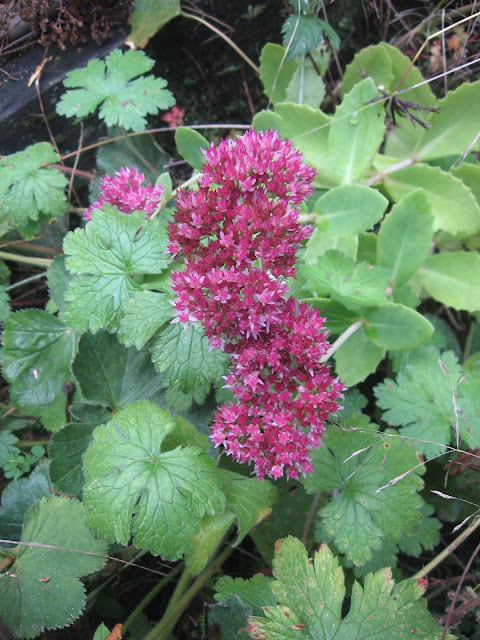I threw together a much less elaborate tomato covering this year, using the pvc pipe I had cut last year for my extensive tomato house, and 10' wide plastic sheeting. I only covered the shorter determinate tomatoes, because of time and difficulty constraints. Covering protects from frost and also keeps the rain from splashing up late blight spores on the plants and deters its development. I grew mostly the short tomatoes this year because of the discouraging cold springs we have had the last 2 years that result in the tomatoes being a whole month or more late in ripening. I was also using them as poisonous roots to protect interplanted beans, and I considered this a success, something worth doing again next year. The short plants resulted in a lot less work doing staking, running wire supports, and tying up vines. I could use just 1-4 bamboo stakes per plant for staking, and ran only one longitudinal wire down the rows to which I could tie some of the stakes for stability. With taller tomatoes I typically would have 4 wires run at two levels for a bed 2 rows wide, to which I would tie vines as well as additional bamboo poles for stability to tie up additional vines and keep the wires from sagging. There were a few tomato cages thrown in at intervals to support some vigorous growers. I tried some varieties I had not grown recently, or that had not sprouted for me before using peat pots. I get much better germination, especially of old seed, with ziplock bags and damp paper towels.
This was my determinate tomato list , source, name, started, and yields in pounds-
TSF Azure paste det 2/8/2011 4.53
MS Martino's Roma det 2/8/2011 8.44
HL Mtn Princess det 2/7/2011 7.81
MS Napoli det 2/7/2011 7.56
***tr New Big Dwarf det 07 2/7/2011 13.81
TSF Novinka Kubani det 2/8/2011 2.38
EH Or Spring det 04 2/7/2011 1.81
SH Prairie Fire det 2/7/2011 1.25
EH Princip Borghese det 2/7/2011 7.44
ALF Ropreco det 2/7/2011 1.77
MS San Remo det 2/7/2011 3.19
SH Siberian Pink det 2/7/2011 0.22
SH Tricot Czech det 2/7/2011 4.81
I did have more plants of New Big Dwarf.
This was my indeterminate tomato list and yields-
ebay Rostova heart ind 2/7/2011 10.47
ebay Shilling Giant heart ind 2/7/2011 12.56
ebay Super Italian Paste ind 2/7/2011 1.31
ebay Virginia Sweets ind 2/7/2011 1.31
Total yield- 90.67 # at $3.00 per pound for organically grown = $272
(Sources- Abundant Life Seed Foundation- reduced varieties after fire, Ed Hume, Heirloom Seeds, Mariseeds, Sandhill, trades, Tanager Song Farms- not selling seeds at present)
While I liked the heart tomatoes, which is my favorite category of tomato, meaty, few seeds, and often with a luscious texture and taste, I will return next year to some of my old standbys, Verna's Orange Oxheart, Sochulak, and Ukraine Heart. I also want to find new seed for an old favorite bicolor, Lucky Cross, the last time I grew it, it didn't come true from seed. I want also perhaps to try some other bicolors, since I like their texture and fruity flavor.

Here is my tomato covering this year, rather makeshift. I had to add some flying buttresses since my first attempt was not stable enough and leaned , had some sagging which filled with water, etc. Being able to pull the plastic tightly to the vertical supports kept it from sagging, and I ran the plastic to the ground on the windward side so had no blowing over problems after the first adjustment. It is working to prevent late blight and frost destruction. There was at least one night below freezing. I may still be able to get enough tomatoes for our salad for a while. Here are some tomatoes under my cover, Ropreco-
And another paste, Martino's Roma-
And these are my tall indeterminate plants which have not been covered for comparison, completely decimated by late blight and frost-
Another tomato I will grow next year again is Legend, which is rather late but has some late blight resistance so can fill out that difficult late season ripening slot. I also want to pursue the early ripening cold tolerant tomatoes a little more.
I research tomatoes on the
Gardenweb forum. Plus I like their bean forum and others, lots of archives to search.
Happy Fall, Hannah




















































